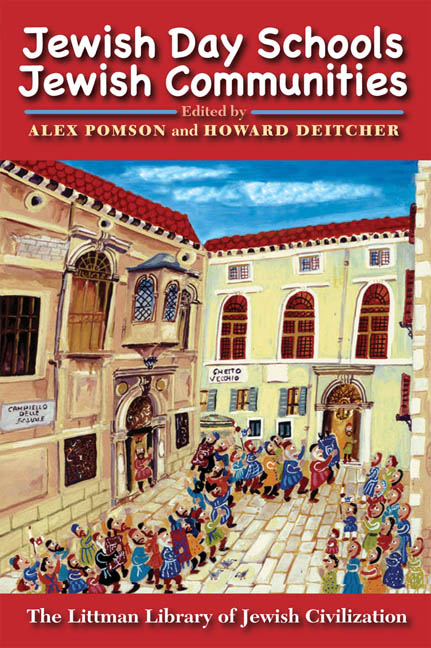Book contents
- Frontmatter
- Dedication
- Acknowledgements
- Contents
- Note on Transliteration
- Introduction: Jewish Schools, Jewish Communities: A Reconsideration
- PART I Insights from Public and General Education
- PART II Cross-Cultural Insights
- PART III Insights through the Prism of Community
- 13 Relationships between Schools and Parents in Haredi Popular Literature in the United States
- 14 The Impact of Community on Curriculum Decision-Making in a North American Jewish Day School
- 15 Ideological Commitment in the Supervision of Jewish Studies Teachers: Representing Community
- 16 Schooling for Change in the Religious World: An Educational Experiment in a Religious Junior High School in Israel
- 17 Home-Made Jewish Culture at the Intersection of Family Life and School
- 18 Teacher Perspectives on Behaviour Problems: Background Influences on Behavioural Referral Criteria and Definitions of Rebellious Behaviour
- 19 Shabbatonim as Experiential Education in the North American Community Day High School
- 20 Teaching Leadership through Town Meeting
- 21 Building Community in a Pluralist High School
- Contributors
- Index
16 - Schooling for Change in the Religious World: An Educational Experiment in a Religious Junior High School in Israel
from PART III - Insights through the Prism of Community
- Frontmatter
- Dedication
- Acknowledgements
- Contents
- Note on Transliteration
- Introduction: Jewish Schools, Jewish Communities: A Reconsideration
- PART I Insights from Public and General Education
- PART II Cross-Cultural Insights
- PART III Insights through the Prism of Community
- 13 Relationships between Schools and Parents in Haredi Popular Literature in the United States
- 14 The Impact of Community on Curriculum Decision-Making in a North American Jewish Day School
- 15 Ideological Commitment in the Supervision of Jewish Studies Teachers: Representing Community
- 16 Schooling for Change in the Religious World: An Educational Experiment in a Religious Junior High School in Israel
- 17 Home-Made Jewish Culture at the Intersection of Family Life and School
- 18 Teacher Perspectives on Behaviour Problems: Background Influences on Behavioural Referral Criteria and Definitions of Rebellious Behaviour
- 19 Shabbatonim as Experiential Education in the North American Community Day High School
- 20 Teaching Leadership through Town Meeting
- 21 Building Community in a Pluralist High School
- Contributors
- Index
Summary
SCHOOLS SHAPE COMMUNITIES as much as communities shape schools. As bell hooks writes, as we work at transforming educational institutions, we are ultimately transforming society ‘so that the way we live, teach, and work can reflect our joy in cultural diversity, our passion for justice, and our love of freedom’. Thus schools are places that reflect the values of a society, while holding the potential to transform the injustices in society and deconstruct social hierarchies.
Race and Class in Religious Schools in Israel
Although compulsory state schooling in Israel, enacted in 1949, was intended to provide equal educational opportunities to all the country's citizens, ethnic and class differentiation gradually became entrenched in the system. The educational historian Chaim Adler describes how, from Israel's inception, certain state policies of ‘absorption’ had a discriminatory effect on immigrants from Middle Eastern countries—oriental Jews, Sephardis, or mizraḥim. ‘The disadvantaged socio-economic position of Middle Easterners stemmed inter alia from the differential treatment by the official agencies during the initial period of “being absorbed”.’ Moreover, since the 1950s in Israel was a period in which ‘Israeliness’ was being moulded, the school system reflected that political goal, in which images of ‘Israeli’ generally meant Ashkenazi, or European. The sociologist Shlomo Swirski argues that ‘the entire cultural world represented in the Israeli curriculumwas and still is almost exclusively the world of European Jewry’.
Formal structures in the school system matched this cultural hierarchy from the earliest days of the state, when Ashkenazi and Sephardi Jews were given different educations. The ethnographer Arnold Lewis writes that schools were divided into two sections, one composed of ‘small classes of veterans and new immigrant children from Eastern Europe who progressed along the path towards academic high school’ and another which ‘stressed reading, writing and other basic skills, [and] was opened and filled mostly by children of North African and Near Eastern immigrants’, who, upon completing this programme, ‘were prepared to enter a trade as the level of education did not meet the standards for admission into academic high schools’. This practice of ethnically divided school groups remained formally in place through the 1960s.
- Type
- Chapter
- Information
- Jewish Day Schools, Jewish CommunitiesA Reconsideration, pp. 289 - 306Publisher: Liverpool University PressPrint publication year: 2009

